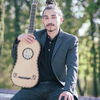
-
Capacity
- 25 of 25 spots still available
-

- Don't bring your own drinks
- Alcoholic and non-alcoholic drinks provided
-
Wheelchair access
- Not wheelchair accessible
-
- Kid-friendly event
This is a groupmuse
A live concert in a living room, backyard, or another intimate space. They're casual and friendly, hosted by community members.
Hosts
Native of New York and currently based in Madrid, Jon Wasserman is a specialist in plucked string instruments with experience performing historical plucked string instruments, such as theorbo, lute, vihuela, 5 course guitar, and 4 course guitar, in addition to acoustic/electric/classical guitars, mandolin, banjo, ukulele, sitar, bass guitar, and voice among other plucked string instruments. He has performed in venues ranging from Carnegie Hall in New York to ancient churches in Quito, Ecuador or the Cathedral of Granada, Spain. Wasserman is an in-demand lutenist and guitarist, regularly performing with ensembles across the United States, Europe, and South America.
To see and hear Jon's music check out his website https://www.jwassermanmusic.com/
And, to hear him in person, please make a reservation to reserve a spot.
A light snack and beverage reception will follow the performance.
What's the music?
(Red Loves) is a program representing the lyrical and musical world of the 16th and 17th
century Hispanic diaspora, highlighting works for the vihuela and baroque guitar. The music
comes from 16th century Iberia and 17th century Spain, Peru, Mexico, and Chile, featuring
composers such as Luis Milán, Luys de Narvaez, Diego Pisador, Santiago de Murcia, José Marin,
and anonymous composers. The works from these composers include virtuosic fantasies
(fantasias), dances (danzas), variations (diferencias), interspersed with renaissance
villancicos and intabulations of vocal music as well as, tonos humanos, a genre of
accompanied song from the baroque.
The program is split into 2 parts to highlight the two distinct musical periods. The first will
feature music from the renaissance performed on the vihuela, and the latter from the
baroque performed on the baroque guitar.
The name “Amores Rojos” comes from the research of the music that survives for the vihuela
and the baroque guitar which is written in a notation called tablature. The tablature is shown
by lines (representing strings) and numbers (representing frets). This was the most common
method of writing music for plucked stringed instruments since the 16th century to the
modern day. In the 16th century, the uniqueness of this repertoire is that the vocal lines were
not written above the tablature staff but, actually colored in red into the tablature itself. This
technique was called “cifras coloradas” (colored symbols). By studying this music I have
made my own arrangements from the original manuscripts, choosing which notes to be sung
and which to be left out of the instrument.
Location
Exact address sent to approved attendees via email.



 Continue with Facebook
Continue with Facebook
 Continue with Google
Continue with Google
 Continue with Apple
Continue with Apple
Comments
Comment sections are only for participants. Please sign in and reserve a spot above to view comments.